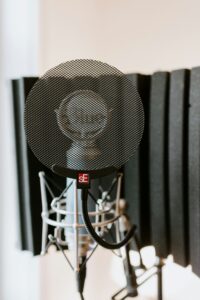Once upon a time not so long ago, I was on a call with a fellow voice-over artist and heard the phrase “punch and roll”. This was a completely new phrase to me, and I had no idea what it meant.
But it was one of those situations (you know the ones) where it felt like I should know and if I admitted I didn’t know then I’d look, well, stupid. I mean, I was a professional voice-over artist. I had been for about three years at that point. This felt like something I should already be aware of.
After battling a massive wave of imposter syndrome, I finally got off the call, and immediately googled to learn what “punch and roll” meant. 
So, if you’re in the same boat as me and you’re not sure, never fear. Let’s begin with some definitions.
What is Punch and Roll?
Punch and roll (or Punch’n’Roll) is a method of recording which “enables you to correct and fix the errors that you make during your recording sessions. While recording, when you make a mistake, you can stop, back up over the mistakes and then continue on with your recording session” (Audacity).
Employing this method, when you step out of the booth at the end of a session you have a clean recording with (most likely) no mistakes. Your work is ready for editing and a quick QC (quality check) and you’re on your way.
Why WOULDN’T you use Punch’n’Roll?
So, why doesn’t everyone do this? Good question. The reason I’d never heard of the phrase (and why I don’t employ this method) is surprisingly simple – my recording set up.
Like many other voice-over artists, I record in my closet. I call it a studio because it’s sound treated and I have nice equipment, but truthfully, it’s just a repurposed closet.
And, for two reasons, I don’t keep my computer in the studio with me.
- There isn’t space.
- My computer has a fan that comes on after prolonged use. This noise can be heard in the recording.
If I wanted to record punch’n’roll-style, I’d have to…
- open the door
- stop the recording
- rewind back
- start again
- go back into the booth
…EVERY TIME I MADE A MISTAKE.
And honestly, this would take me FOREVER. Instead, when I work, I record straight through.
Recording Straight Through
This option works well for many of us. We simply hit record, hop in the booth and keep recording until we’re finished. Everything’s recorded, mistakes and all. We just fix it in post-production before delivering it to the client.
Doesn’t editing take forever?
You’d think so. But there’s a quick and easy trick to minimize your editing time. When in the booth, simply snap, clap, or click your tongue each time you make a mistake. This will show up as an obvious spike in the audio when it comes time to edit so you can easily spot mistakes WITHOUT having to listen to the entire recording and pick them out.
What if a client wants Punch’n’Roll but I record straight through?
If a client asks for a punch’n’roll recording, this simply means they want a clean recording with no obvious mistakes and no post-production editing (effects like noise reduction or normalization, etc.) It doesn’t mean you have to record using the punch’n’roll method in your space. I deliver punch’n’roll to clients all the time even though I record straight through in the studio. You can always let clients know the method you use though, especially if they’re doing a live-directed session and assure them that the final product will be the same.
If punch’n’roll works for you and your recording set-up, then go for it. But if it’s easier to record straight through and cut out mistakes later, then do what’s best for you.
As Tim Gunn says, “make it work.”
Caroline Turner Cole is a voice over artist, writer and yogi. Follow along or say hey on Instagram and Twitter! So, when I record projects I hit record, hop in my booth and close the door.





